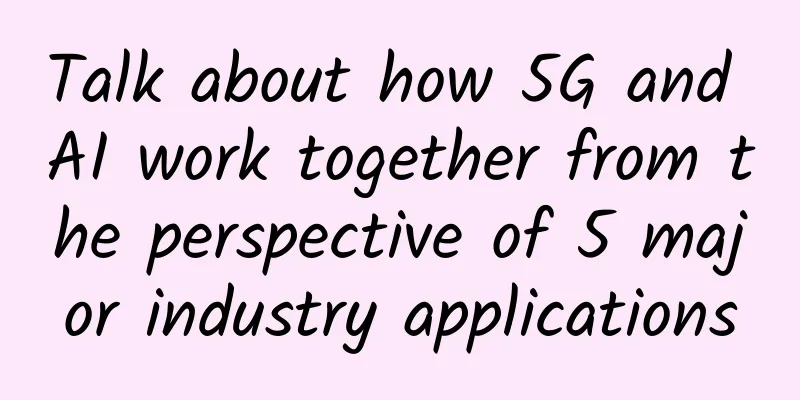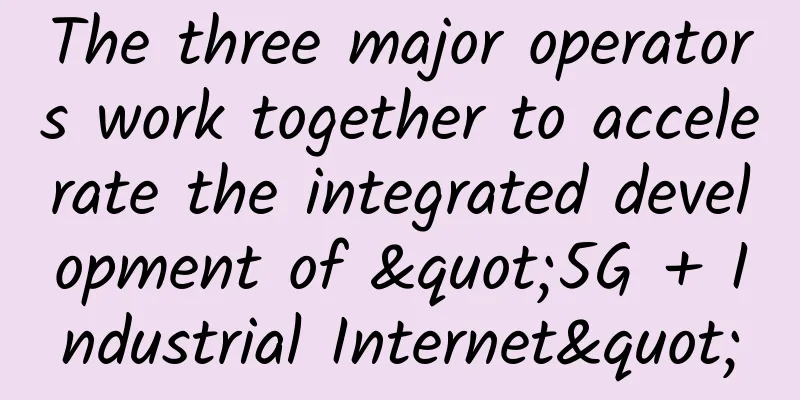Talk about how 5G and AI work together from the perspective of 5 major industry applications

|
As new technologies continue to emerge, more and more technologies are being merged and combined to enhance functionality while simplifying the user experience. In fact, the combination of fifth-generation cellular technology and artificial intelligence technology is also a perfect example, which helps today's innovators collaborate and apply two independent concepts to develop new cases and improve past creations to better meet future needs. Future-oriented 5G evolutionThe combination of AI and 5G technologies will change business models and the speed of innovation across many different industries – from healthcare and transportation to entertainment and more. As we know, technological transformation is expected to make an impressive contribution to the global economy. According to a research report by ABI Research, by 2035, the total output of AI and 5G combined will reach 17.9 trillion US dollars, accounting for 0.7% of global GDP. A large part of the direct contribution of AI and 5G will come from the 5G ecosystem, and 5G will become the main technology for many industrial applications. So how will the combination of AI and 5G revolutionize the world as we know it? Most notably, the combination of the two can better improve the operational efficiency of the system. 5G technology can transmit information quickly and with low latency, while AI minimizes operational complexity by utilizing efficient algorithms. This means that the equipment that uses them will be faster and more efficient. In addition, the combination of 5G and AI will improve the cost-effectiveness of various processes through the use of automated systems. This automation can reduce the manual workload and cost required to perform industrial functions while improving precision. Applying AI and 5G in the network can also help enterprises reduce capital expenditures, develop new revenue sources and improve network performance. AI is already being used to help service providers recover their investments in adopting and enabling new 5G applications, and AI is already simplifying network evolution and improving performance across networks. Network optimization through distributed intelligence and edge capabilitiesAn important element of using AI and 5G together is distributed intelligence, as this allows computing functions to be distributed across the entire infrastructure. Distributed intelligence comes from the cloud to the edge, enabling on-demand deployment of computing resources and AI, and can change the way information is processed to simplify technical complexity and improve infrastructure operational efficiency. The adoption of 5G and AI will support the intelligent wireless edge, where edge cloud, processing data on edge devices and 5G are combined to form a ubiquitous intelligent connection structure. In addition, 5G's high capacity and low latency can enable new and improved functions because AI processing can be distributed between devices, central cloud and edge. Leveraging 5G and AI at the edge will enable edge cloud to process data closer to its source through low-latency 5G or on-device AI processing, making it possible to process data closer to the source, helping to provide greater reliability, personalization, and security. How AI is changing 5GUsing AI technology on 5G networks and 5G devices can provide multiple benefits and improve wireless challenges brought by traditional methods. For example, with AI minimizing operational complexity and 5G technology’s low latency, devices can have longer battery life and improve efficiency, providing users with more enhanced experiences. Artificial intelligence can improve 5G networks by improving network security, increasing network efficiency, improving service quality, and providing more simplified deployment. In addition, the use of AI machine learning can improve 5G devices in terms of system performance, security, and device experience. How 5G will change AIAs AI becomes so pervasive and necessary in a variety of systems, the addition of 5G can help improve AI capabilities. 5G can support AI deployment and develop new AI uses through distributed AI. Because 5G has both high capacity and low latency, using it with AI can allow for distributed AI processing, providing greater flexibility for new capabilities. Using 5G in AI functions can improve the AI-enhanced experience for users. For example, by using 5G links, borderless XR can split AI workload rendering and processing between devices and edge clouds, which means being able to create personalized experiences for customers or create more engaging experiences for entertainment purposes. 5G and AI trends and applications to watch out forSo, how will we see the application of 5G and AI in our daily lives? In fact, the combination of these technologies has begun to innovate new possibilities for all walks of life. 1) Medical The healthcare industry’s use of 5G networks will enable doctors to perform remote surgeries with the help of AI-powered robots, making healthcare more accessible and more efficient, especially in remote or underserved areas. 2) Customer Service 5G and AI are essential for enhancing customer service and customer experience. AI technology can provide shoppers with personalized purchase recommendations based on their interests or previous customer data. It can also open up new ways to present products to shoppers. Connectivity expansion through 5G networks can improve retailers' sales capabilities, and pairing it with AI can support augmented reality services to provide customers with product information. For example, Walmart uses edge computing services to improve customer experience by collecting, sharing, and utilizing real-time analysis of data across its retail network, which enables them to provide shoppers with immersive augmented and virtual reality services. 3) Self-driving cars Thanks to 5G, the dream of AI-powered self-driving cars is becoming a reality. Autonomous vehicles will need fast and reliable connections to communicate with each other and the surrounding infrastructure, and 5G networks will provide the necessary connectivity to make this possible. 4) Augmented Reality With 5G networks and AI, gamers and spectators will be able to enjoy ultra-low latency and high-definition graphics. This will enable new forms of immersive and interactive entertainment and further improve virtual and augmented reality. 5) Industrial Automation 5G networks and artificial intelligence will enable industrial robots to communicate with each other and the people who operate them, supporting existing industrial automation and will lead to safer, more efficient and cost-effective manufacturing processes. Original title: How 5G and AI will work together Original author: Madeline Clarke |
<<: What else will we look forward to in the communications industry in 2023?
Recommend
Five ministries and commissions issued the "Guidelines for the Construction of the National New Generation Artificial Intelligence Standard System"
Recently, the National Standardization Administra...
Huawei: "Intelligent Distributed Access Network" creates true gigabit high-quality life experience
On October 15, Huawei held a press conference tit...
Teach you Socket communication (TCP/IP) step by step
Two programs on the network exchange data through...
China Unicom and Huawei jointly launch innovation to build differentiated advantages in 5G-A
[Barcelona, Spain, February 26, 2024] Huawei an...
MIIT: 4G and 5G will coexist for a long time, and 5G will not be built to dismantle 4G or limit speed
On August 22, Wen Ku, Director of the Communicati...
In the Internet Queen’s “Spring Festival Gala-style report”, what are the things worth spending five minutes paying attention to?
Internet Queen Mary Meeker's annual Internet ...
Recommend an information collection tool written in Python
introduce Argus is a Python-based information col...
It is urgent for operators to improve network operation and maintenance
Communication networks are the underlying infrast...
From 5G to 6G: The race between innovation and disruption
McKinsey's 2022 Technology Trends Outlook sho...
New space age opens opportunities for edge computing
Satellite communications are starting to become f...
The computing power network came into being, and the service model will change from "resource-based" to "task-based"
The 21st century is a period of vigorous developm...
80VPS: US 8C cluster server monthly payment starts from 800 yuan, Hong Kong 8C cluster server monthly payment starts from 1000 yuan
Recently, some readers asked about cluster server...
Juniper Networks' Shaowen Ma: The best SDN controller for cloud computing
[51CTO.com original article] The interview with M...
Pre-terminated trunk copper cable and method of using the same
High-density cabling products and standard modula...
IMIDC server restock: Hong Kong & Taiwan starting from $39/month / Japan server starting from $49/month
IMIDC (Rainbow Network) Hong Kong, Taiwan and Jap...









